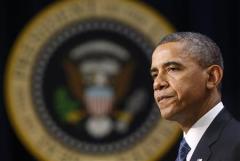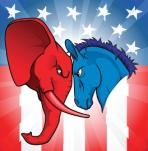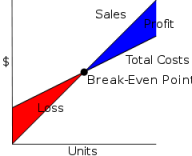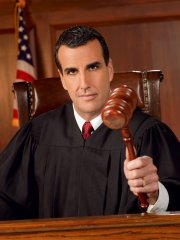Archive
More to Lemonade Than Just Lemons
In Economics class one day, we took a trip town to Mr. O’s good ‘ol lemonade stand. In this hypothetical activity, we examined a lemonade stand in detail from an economic standpoint. Something as simple as a lemonade stand remarkably represents a business from an economics point of view and starting with this simple example helps to understand multiple important aspects of a business.
 The details of the stand given to us were that you have decided to open a lemonade stand in your neighborhood. Out of some boards, nails, and paint you build your stand at a cost of $20. You buy a cooler to store ice for $10. You do a bit of research and learn that paper cups, ice, lemons, sugar, and water are going to cost 25 cents per cup of lemonade. You decide to sell lemonade for 50 cents a cup.
The details of the stand given to us were that you have decided to open a lemonade stand in your neighborhood. Out of some boards, nails, and paint you build your stand at a cost of $20. You buy a cooler to store ice for $10. You do a bit of research and learn that paper cups, ice, lemons, sugar, and water are going to cost 25 cents per cup of lemonade. You decide to sell lemonade for 50 cents a cup.
From that simple hypothetical, we began by examining the fixed costs. Fixed costs are the cost that does not change no matter how much of good is produced. In this instance, they may be referred to as “startup costs”. The fixed costs in the lemonade stand were comprised of the boards, nails, paint, and the cooler. No matter what, these costs are not going to change even if the amount of lemonade sold per day fluctuates. These costs are set and are an immediate “consequence” (so to speak) of starting up a business. The fixed costs are the inevitable implementations of the beginning of a business thus earning their nickname “startup costs”. Using the fixed costs as a starting point of the business, we moved on to variable costs.
Variable costs are costs that rise or fall depending on quantity of goods produced. The cups, ice, lemons, sugar, and water, and even the lemonade itself are the variable costs in Mr. O’s lemonade stand. The variable costs get their “variable” because for each cup of lemonade the cost for the seller is going to be 25 cents. Each day, the producer is not going to sell the same quantity of goods (lemonade) so his production costs are going to differ. If he sells 25 cups he will lose $6.25 to variable costs (.25 * 25), the next day the producer could sell 100 cups costing him $25. The variable costs vary from day to day as demand varies. Thus the variable costs are factored into a business plan with regards to how much of the good is sold.
How many cups of lemonade must be sold in order to break even? What does a business have to do in order to begin making a profit? In economics terms, you break even when the marginal revenue is equal to the total costs, or the fixed costs plus the variable costs. In the hypothetical, our fixed costs were $30 and are variable costs were $.25 for each cup produced. Our marginal revenue, or the additional income from selling one more unit of a good, sometimes equal to price, was $.50 cents for each cup sold. From there it was a math equation…
Let x=cups to be sold in order to break even.
Marginal revenue=fixed costs +variable costs
.50(x)=30+.25(x)
.25(x)=30
x=120 cups
Though a simple example, the lemonade stand represents the reality of breaking even in a business. Mr. Ostroff used the example of an actual drivers ed business idea being put into practice. Using his fixed costs and his calculated variable costs, he was able to evaluate the amount of students that would make his marginal revenue equal to the amount of his total (fixed and variable) costs. This simple equation can be applied with slight alterations if the fixed costs differ from the first year (permits, etc.) but is a simple equation that calculates how you start making profit in a business!
We continued to examine how to react to different situations in a business. We examined shut down decisions and whether or not it would be appropriate to close down the lemonade stand. If the weather was cold and rainy and your variable costs were more than your revenue, you should shutdown production. That is when you aren’t selling enough cups to cover the cost of making them you are simply losing money. This again is applicable to any modern day business, if you are producing a good and you can’t generate enough revenue to cover production costs then you will continue to lose money and the shutdown decision comes into play.
Finally, we examined the equilibrium price. The point of equilibrium in the business is when quantity demand and quantity supplied is equal. We looked at how sales would be affected by certain situations and how our equilibrium price could be found and adapted to. This is a common reality in the modern business world with competition constantly changing, prices continuously fluctuating, and situations commonly arising. We looked at the situations, and then found out what we could deduce about the equilibrium price. If you have a great day and sell-out of lemonade by lunch time, what happens?
The graph shows that the equilibrium price would be higher than her and she needs to raise her prices to avoid excess demand. She sold all of her goods too quick showing a large demand but a small supply, thus excess demand.
On the other hand, if your neighbor decides to open her own stand and sell iced tea, what would happen to the equilibrium price for lemonade? This situation is much different. The competition introduced causes the equilibrium price to be below yours. The seller needs to lower his or her prices to avoid excess supply.
All in all, this hypothetical demonstrated something that people see everyday in the business world. The simple example could have represented even large business’s ways of calculating profit. The activity was successful in helping me understand the application of many of the terms we learn in economics and very helpful in providing a real life example of how the study of economics is applicable.
Strict or Loose Scrutiny?
Recently in government class, we discussed the judiciary aspect of the Untied States. More specifically, we performed a mock trial representing that of Fisher v. University of Texas. To start with a broad approach, an understanding of the Judiciary system in its whole is necessary to understand the trial. The United States abides by an adversarial court system in which a judge plays a relatively passive role as attorneys battle to protect each other’s sides (Choices 250). This system is directly translated into the court systems and is the format of the Fisher trial. When dealing with cases, they can either be under a civil or criminal category. The civil courts deal with seeking compensation while the criminal courts seek punishment (Choices 250). The Fisher case presents an interesting part of the judiciary system as it is debated that some judges often use precedent and maintaining the authority of the judicial system as the foundation of their decision vs. the judicial philosophies of the founders (Parish Gov). The Fisher case is not only a fun activity due to the fact that we are in the shoes of the Supreme Justices and have the ability to deliberate but it also shows how such a little “bump in the road” can reflect something so huge in the federal sense; a trial concerning the Fourteenth Amendment.
The trial consists of a petitioner, Ms. Fisher, making a claim against the University of Texas. She is challenging the university’s use of race in its undergraduate admissions process (Scouts Blog) and bringing Affirmative action into question. Affirmative action is defined by the American Civil Liberties Union (ACLU) as one of the most effective tools for redressing the injustices caused by our nation’s historic discrimination against people of color. It provides for equal opportunity when dealing with employment, and in this case, admission. The university considers academic and personal achievement when dealing with their admissions. They claim that they use a “narrowly tailored” mean of pursuing greater diversity (Oyez). Ms. Fisher, on the other hand, disagrees and says that her race hindered her from being accepted to the university. She claims it was a determining factor rather than one taken into consideration. Under the Grutter v. Bollinger, the Supreme Court argued whether “student body diversity is a compelling state interest that can justify the use of race in university admissions.” It was ruled that the admission policies at public interests must be “narrowly tailored” to pass strict scrutiny (Cornell Law).
Naturally, there is a conservative opinion and a liberal opinion. The conservative side is questioning the Fourteenth Amendment that guarantees equal protection of the laws without regard to a person’s race. Fisher contends that UT’s ten percent law achieves diversity within the race-conscious university and that when considering those outside of the ten percent (where she is placed), race is being used as a determining factor (Cornell Law). The conservatives also bring into question what the University of Texas calls “critical mass”. As they are unable to clearly define it, critical mass is an ambiguous “quota”. They want to achieve a certain percentage of each race within their student body and classes, which is strictly unconstitutional. Statistics show that in the years leading up to Ms. Fisher’s denial of admissions that this “quota” was present as the race percentages remain stagnant. See facts (here)
The liberals contend that UT’s Ten Percent Law is insufficient to achieve the diversity it needs. It has increased diversity overall, but the left side claims that UT is yearning to achieve diversity within each racial group. As they yearn to create a richer educational environment, the aim to use all the aspects of their applicants in order to create a more diverse institution (Cornell Law). The liberals claim that the admissions process will prepare students for a diverse society after they leave the university, when generally speaking, makes sense. The university is trying to avoid a monotonous student makeup). They use this goal as a basis to deny the claims that their policy sets quotas and/or targets minorities for admissions. The liberals also contend that since the university does not monitor the racial composition of the class during the admissions process, it renders their accused policies as impossible. (American Bar)
Now for my perspective, it comes down to Strict Scrutiny and Affirmative Action. Whether there is this “Critical Mass” is a determining factor. The university claimed that it considers race in its admissions process until the student body has a “critical mass” (Scouts Blog). There is a fine line between factoring in or taking into consideration and being a determining factor that needs to be clearly explained in this case. The university needs to define their critical mass and be reviewed to a point where the holistic review after the Top Ten Percent Law would better the diversity as a whole, not only race. This process needs to undergo Strict Scrutiny and be reviewed once more to assure that race is a factor considered rather than used to determine.
This case proves that their may be more to a small issue. A simple denial to a college brought about a trip to the Supreme Court and an Amendment in question. When it comes down to the equal rights clause and strict scrutiny though, race can be a huge and influential factor but only to a certain extent. The benefits of being diverse are a reality, but they should only be applied to constitutionally acceptable standards. Diversity shouldn’t be defined; let it achieve itself.
Gun Control— A War Without a War
When you search the phrase “gun control” on any search engine, responses leaning way to the left are going to pop up. Funny thing is, responses leaning way to the right are going to pop up right with them. Even worse, each response, despite which party it belongs to, is going to be attacking the other parties’ response!
Now as “one nation under God, indivisible,” that doesn’t sound too good. We have this piercing issue causing social media “wars” and dividing our nation into two very opinionated halves. The problem is, we have two halves that won’t budge their hold to meet in the middle. It’s one huge game of tug-o-war.
The flag in the middle of this game is the good ol’ second Amendment. Some say restrict, some say let it be. The problem is that we have citizens fighting selfishly to get what their side wants rather than opening their ears to a compromise. We as a nation aren’t working together to meet somewhere sensible that puts an end to the tragedies without hindering the purpose of our Bill of Rights.

President Obama proposed “criminal background checks for all gun sales; reinstating the assault weapons ban; restoring a 10-round limit on ammunition magazines; eliminating armor-piercing bullets; providing mental health services in schools; allocating funds to hire more police officers; and instituting a federal gun trafficking statute” (Huffington Post). The details of statistics and magazine capacities could be analyzed and broken down and a never ending argument could be started with myself, but if we break a little here, we can funnel this back to the Modern Presidential Roles. If his proposal is analyzed, the role in which he played is leaning towards the Chief of Party. Here, we have a big, bold, and BLUE statement. The president is acknowledging his duty to be the leader of his party here, as his proposal is unarguably liberal.
Naturally, the republicans were against his decision. That’s how this system works. Wanting the second Amendment to remain unchanged, banning assault rifle-type weapons would violate their main wish. The RED side, of course, wants the violence to end, but are highly against their rights being infringed upon. Assembly Republican leader Jon Bramnick commented on New Jersey gun control legislation saying, “that Democrats in New Jersey have decided to rush through legislation that is drafted poorly and doesn’t begin to solve the problems that we’ve seen across the nation with respect to violent shootings” (Philadelphia Inquirer) .

Although the common situation is present; each party fighting for what they want, there is more behind a simple wish. The republicans are wanting the POTUS to play a different role as the leader of a nation. In reality, they wished President Obama had sided with Rossiter’s role of Voice of the People proposing a two fold bi partisan plan. If the President acts as the political leader of both parties, he “serves as the moral spokesman for all.” There is a huge gap in terms of agreement between both parties in-between the two roles. Initially, any person looking at this just sees it as a liberal plan. But, through examination of the Presidential powers, it is clear that there is more than just a different point of view behind the decision. The study of government allows us to see more than what the press says or what social media posts. It allows for insight, so to speak, or a further understanding behind modern politics. The bias nature of our nation can be put aside for a minute and we are able to see the true intentions and meaning behind certain legislations, proposals, comments, etc.

As a gun owner and an avid hunter myself, naturally I would be in favor of the second Amendment—as this is what the public says I should be saying. As a citizen, it’s my duty to have an opinion. But, my aim is to be a young scholar-citizen. Not a “Texan,” or a “hunter,” or a “gun owner”. The constituents in a nation have to be educated and aware of their surrounding events in order to developed an opinion beneficial. Education is what is going to allow our nation to thrive.
In the end, gun control, a hot topic in our nation and media, is an important aspect regarding our safety in our nation. But, lets get mathematical here, I was able to “derive” something much more important. There’s more to current events than getting what your party wants. As a young scholar-citizen, understanding government allows you to develop opinions beneficial to the nation as a whole. I will have my opinions and I may lean left or right, but in the end, in 10 months I’ll be able to vote and as an educated government student I’ll be voting for what is best for our nation as a whole.
Ford N




